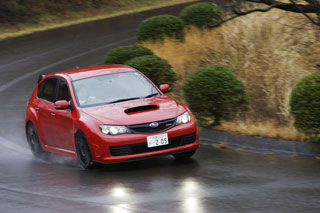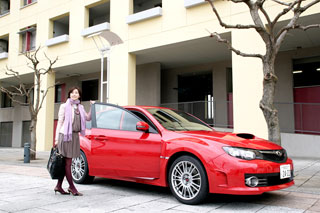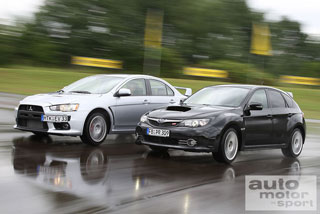Subaru Impreza WRX STI test drive since 2008 sedan
The test drive of the updated version of Subaru Impreza WRX STI. What happened to STI?
 Remember the brutal, hard, uncompromising Subaru Impreza WRX STI? The STI who boldly challenged Mitsubishi Lancer Evolution?
Remember the brutal, hard, uncompromising Subaru Impreza WRX STI? The STI who boldly challenged Mitsubishi Lancer Evolution? The STI that was quick and interesting in management? Who took the newly made drivers who are inverted on a straight line and later enter the turn and threw them into ditches, bushes and other irregularities of the landscape? Remember this car? Then, most likely, you will not like this. He was castrated.
I mean that he became slower. You see, speaking of the Subaru WRX STI of the 2011 model year, Subaru engineers promised to make a car that would be radically different from the basic WRX. And it officially took place.
Alas and ah
When we previously tested Subaru WRX STI in 2009, to a hundred it accelerated in 5.2 seconds, and a quarter mile passed in 13.5 seconds, accelerating at the finish of up to 163 km/h. This time, in the same conditions and with the same driver at the wheel, STI 2011 exchanged a hundred in only 5.5 seconds, and spent 13.8 s on the quoter at a speed of 156 km/h at the finish line.
The situation exacerbates that the Subaru WRX STI 2011 is equipped with exactly the same engine with the same power as the previous model, they have the same gear ratio and the main pair, and the weight gain is very insignificant. Moreover, this car on the quota was slower than WRX 2011, which we tested in September.
What is left
The engine has not undergone any significant changes that should be paid attention to. Under the hood is still the 2.5-liter turbocharged opposite motor with four cylinders, which worked on the first models. Yes, of course, he underwent some changes, added a little in power, twisting and cutting off the turnover, but in the 2011 model year he remained unchanged.
Subaru argues that this time the STI power is 305 hp. And 393 Nm of the torque, a mechanical mechanical box, gives the torque (if you suddenly forgot) for all four wheels.
 There is still a Driver Controlled Center Differential system, involving a mechanical differential (planetary type) and a clutch controlled by electronics for distribution of torque. There are also differentials of limited friction: Torsen from behind and spiral front.
There is still a Driver Controlled Center Differential system, involving a mechanical differential (planetary type) and a clutch controlled by electronics for distribution of torque. There are also differentials of limited friction: Torsen from behind and spiral front. Also, each STI is equipped with an extremely irritating SI-Drive system, which, according to Subaru engineers, should adjust the throttle reaction to the needs of the driver. In fact, this system can hardly ensure an adequate reaction to pressing the gas pedal even in the most active mode (Sport Sharp), and you need to turn it on each time, turning the key in the ignition lock.
What changed
When I studied at college, one very smart professor shared one of his ideas with us: the difference, to be a difference, should differ. He was right.
We are not at all sure that the changes made by Subaru in the Subaru WRX STI 2011 model can be called changes. After the first test last summer in Colorado, we wrote that the changes in the suspension are barely noticeable, but effective. The truth is that these changes can be felt only in some specific situations, and they did not affect the results of the main tests.
So what has changed? Previously, the rubberized fasteners of the front lower levers were replaced with ball supports, which allows you to reduce the rolls. Which, in turn, according to Subaru, improves steering at a large load. More stringent bushings supporting the rear subframe are also innovation. The road clearance has become smaller than 10 mm, the springs became tougher by 15.6% in front and 53% in the back, reptile stabilizers (both front and rear) are now thicker.
Such improvements should give a tangible result. STI is still shod in Dunlop SP Sport 600 of the size of 245/40 R18 for lightweight (each became lighter than 2 kg) of forged BBS discs.
An experience
As in the case of any other all-wheel drive car, the first transfer is too short to have time to understand anything. The second acceleration is suspiciously sluggish, and by the time you switch to the third, there is a steady feeling that all the horses did not appear at the party.
Management is difficult to characterize unambiguously. It is impossible not to note the excellent balance that managed to achieve Subaru, and especially the fact that an increase in the rigidity of the springs did not result in an increase in the rigidity of the ride as a whole. Undoubtedly, there are cases when only a minimum wheel correction is needed to stay on the chosen trajectory, which, obviously, is the result of the appearance of balls here. In general, the changes are so transparent that only a person who thoroughly knows all the features of the STI can notice them.
With all the above, the car, despite the reduced road clearance, is capable of storming country roads (including gravel) without any problems). A steep turn, a ribbed surface, STI STI did not even notice them.
 Numbers
Numbers The history of Subaru WRX STI tests conducted by our publication over the past three years is a gradual decrease in dynamics and power. Our first full test of the current generation STI showed that the new model exceeds the previous one in terms of dynamics.
But then the situation began to change. STI, which has been undergoing a long -term test (he has been with us for more than a year), is now accelerating faster than at the beginning of the test (see the detailed data below). This car is 0.3 seconds faster when accelerating to 100 km/h and the same when passing a quota than a 2011 model.
Perhaps the most eloquent is the fact that during these three tests the speed at the finish of the quota fell by about 8 km/h, which is strange, because the difference in the mass of these cars is not more than 26 kg. The only logical explanation for this decrease in dynamics fall in power.
The dynamics according to the results of our standard control tests have not improved, despite the numerous changes in the suspension. The lateral acceleration has become smaller (0.90G against 0.89G), the speed on slalom also fell to 113 km/h.
But the braking distance Subaru WRX STI 2011 grew (34.13 m) in comparison with all the other STI that we tested.
Official statement
The North American branch of Subaru (SOA), for its part, does not comment on the results. In a statement published after we sent them the results of the tests, it was said: the results differ slightly; We will pay attention to this issue.
And about the motivation for the acquisition of STI in the light of almost identical dynamics of WRX, SOA offers the following:
 Motivation of STI purchases the ability to experience the experience of managing a real rally car allowed for ordinary public roads. Despite the external similarity, the WRX STI and WRX have only a few minor similar elements in the suspension. WRX STI has a real rally transmission, adjustable differentials and SI-Drive system, and these are just some differences. It provides a unique combination of power, adhesion and handling in a car where you can move every day.
Motivation of STI purchases the ability to experience the experience of managing a real rally car allowed for ordinary public roads. Despite the external similarity, the WRX STI and WRX have only a few minor similar elements in the suspension. WRX STI has a real rally transmission, adjustable differentials and SI-Drive system, and these are just some differences. It provides a unique combination of power, adhesion and handling in a car where you can move every day. We were also informed that the Fuji Heavy Industries concern, the Subaru maternal company, is currently conducting its own testing in order to make sure that we have received the results.
Conclusion
We tested by the car equipped with a package of Limited options (leather upholstery of the salon, hatch and navigation system) will cost the buyer $ 39,870 (including taxes). It is $ 8,150 more expensive than the WRX in the same Limited configuration.
Summing up, we can say that Subaru WRX STI 2011 A capable car. He provides an unsurpassed feeling of control during aggressive driving, he loves complex turns, and the fact that now he is also available in the sedan body only adds attractiveness to him.
It is no less important that it can still enjoy control, regardless of the type of coating by which you are driving. He is very real. But the question remains: why is it less real than its predecessors?


Source: Insideline






